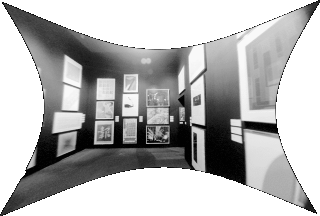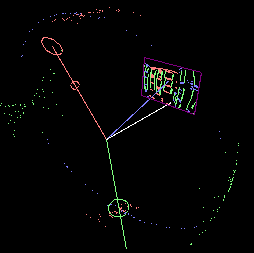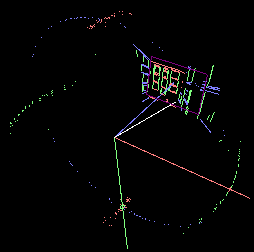Semiautomatic Camera Lens Calibration
from Partially known structure

Take an image that has geometric lens distortions, where straight lines
are curved
 larger 55K version larger 55K version
My algorithm will undistort the image, straightening lines that
should be straight
 larger 140K version larger 140K version
I've corrected for lens distortion by solving for three terms of
radial distortion K1, K2, K3 and two terms of decentering distortion
P1, P2 where
x' = x + x*(K1*r^2 + K2*r^4 + K3*r^6) + P1*(r^2 + 2*x^2) + 2*P2*x*y
y' = y + y*(K1*r^2 + K2*r^4 + K3*r^6) + P2*(r^2 + 2*y^2) + 2*P1*x*y
In this case the estimated parameters came out to be
K1: 1.105763E-01
K2: 1.886214E-02
K3: 1.473832E-02
P1:-8.448460E-03
P2:-7.356744E-03
To solve for the 5 distortion parameters I model estimation error as
vanishing point dispersion. The best estimated 5 parameters are those
that minimize the weighted sum of vanishing point dispersals.
Say we make a Gaussian sphere that describes scene directions
relative to an arbitrary center of projection. Each image segment is
the result of projecting a scene edge thru the center of
projection. Thus each scene edge lies somewhere in the plane created
by the two points of an image segment and the center of
projection. This plane may be described by the two sphere points on
the Gaussian sphere that lie along the plane normal from the center of
projection.
In an undistorted image, all image segments that belong to a set of
parallel lines should intersect at a common point, typically called
the vanishing point. In the Gaussian sphere the sphere points of these
image segments create a great circle whose plane normal points in the
direction of the image vanishing point.
However, if the image is distorted (i.e. subject to lens distortion)
then the set of image segments will not intersect at a common
point. Similarly, the corresponding sphere points will not form a
compact great circle.

For example, here we see segments from the original distorted image. Red,
green and blue line segments denote image lines that belong to scene
edges that share the same scene direction.
Notice the clouds of points on the Gaussian sphere also colored red,
green and blue. Each colored cloud should have sphere points which lie
on a great circle whose plane normal points in the direction of the
vanishing point. However, due to geometric distortion the
corresponding sphere points are dispersed.
This dispersion can be measured as a sum of distances from sphere
points to the great circle's plane weighted by the certainty of that
line segment. When this dispersion measure is minimized (as seen
below) sphere points lie much closer to their respective great circle.

Consequently image segments of the corrected image will intersect at a
common vanishing point and edges which were previously warped will be
straightened.
Besides having the effect of straightening curved lines (as is done by
so called ``plumb-line'' methods) this approach imposes the added
constraint that the projection of parallel sets of lines have a common
and unique vanishing point.

sbeck@media.mit.edu
Copyright © 1994, 1995 by MIT Media Lab. All rights reserved.
|